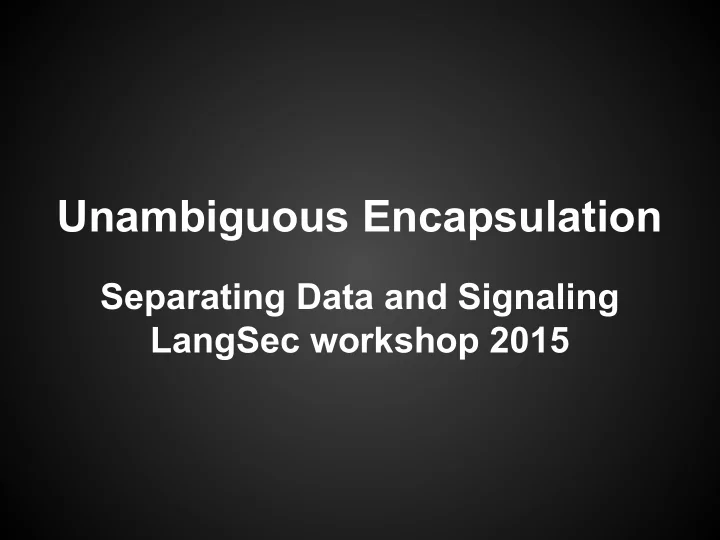

Unambiguous Encapsulation Separating Data and Signaling LangSec workshop 2015
Michael Ossmann Primary on Unambiguous Encapsulation Creator of multiple OSHW projects, Ubertooth, HackRF, Daisho, YARD Stick One Founder of Great Scott Gadgets
Dominic Spill Code for Unambiguous Encapsulation Dev on Ubertooth, BTBB, gr-bluetooth, Daisho, USBProxy Other projects include BeagleDancer, PS/2 tap and fcc.io
Disclaimer The views expressed are the views of the authors and do not reflect the official policy or position of the Department of Defense or the United States Government.
Outline The Problem Unambiguous Encapsulation Error Control Codes Finding Interesting Error Control Codes
Background LANGSEC Packets in Packets
The Problem - Packets in Packets Interference or glitch obscures packet header Second packet in payload Receiver detects second packet Zigbee / Ethernet susceptible
The Problem - Packets in Packets Credit: Travis Goodspeed
Ethernet Too! Credit: Andrea Barisani and Daniele Bianco
The Problem - Buffer Overflow User supplied data written to buffer Overwrite data on stack CPU executes data as instructions
Ambiguous Encapsulation Given a piece of data without context, it is not possible to determine if it is meta-data or encapsulated data
Unambiguous Encapsulation Given a piece of data without context, it is possible to determine if it is meta-data or encapsulated data
If you haven’t found the analog medium beneath a particular bit or byte, keep digging
Error Control Codes Error control codes are used at the boundary between analog and digital Can we find error control codes that provide useful encapsulation properties?
Error Control Codes Encapsulate data in codewords Binary Linear Block Codes encode k data bits in n bit codewords with a minimum Hamming distance d Often designated by [ n , k ] or [ n , k , d ]
[7,4,3] Hamming Code 0101010 1000011 0000000 1101001 0110011 1011010 1110000 0011001 1001100 1100110 0001111 0100101 1111111 0010110 0111100 1010101 Each codeword is 7 bits long, n = 7 There are 2 4 codewords, k = 4 At least 3 bits differ between any two codewords, d = 3
[7,4,3] Hamming Code codeword length = 7 number of codewords = 2 4 minimum Hamming distance = 3 One bit flipped: error corrected Two bits flipped: error detected Three bits flipped: undetected error
Implementation [7,4,3] Hamming encoder: look-up table: 16 * 7 bits [7,4,3] Hamming decoder: look-up table: 128 * 4 bits Much of the complexity of coding theory is related to clever decoding methods, but a look- up table works for shorter (small n ) codes
Brute Force Coding Decoding by look-up table is sort of a brute force approach We can also take a brute force approach to the discovery of new codes
A [5,3,2] Code 00000 01110 00011 10110 00101 11010 01001 11100 Hamming Distance = 2
Isolation 00000 01110 00011 10110 Hamming Distance 00101 11010 01001 11100 = 3 Hamming Distance = 2 Hamming Distance = 2 A code can be thought of as a pair of complementary sub- codes.
A [5,3,2,3] Isolated Complementary Binary Block Code (ICBBC) codeword length = 5 number of codewords = 2 3 minimum Hamming distance = 2 minimum isolation = 3 One bit flipped: error detected Two bits flipped: undetectable error, isolated Three bits flipped: isolation broken
Searching for codes C program to brute force search for codes Depth First Search recursive algorithm
Other search methods FPGA Verilog implementation shows promise Recursion difficult unless we know max depth of recursion at compile time Z3 Python Implementation of icbbc search exist Fast non-exhaustive search
ICBBC Search Search space 2 ≤ n ≤ 8 1 ≤ Hamming distance ≤ n Hamming distance ≤ isolation ≤ n Some larger codes sought [15,7,9] code produce 111GB of output
ICBBC Search Results Results 19,189,776 codes found Symmetric codes [8,3,5] / [8,4,5] - similar subcode sizes Asymmetric codes [8,2,5] - subcodes of 2 / 44 codewords
Isolated Complementary Non-Binary Block Codes (ICNBC) 2 1 a 7-PSK 3 example Lee 0 Distance from 2 to 6 4 is 3 6 5 Lee Distance from (2,1,3) to (6,6,6) is 3+2+3=8
ICNBC Examples 2 symbol codewords, minimum Lee distance of 2, isolation of 5: [(0, 0), (1, 1)] [(3, 4), (4, 3), (4, 5), (5, 4)] 3 symbol codewords, minimum Lee distance of 5, isolation of 7: [(0, 0, 0), (4, 6, 6)] [(3, 3, 2), (6, 4, 3)]
ICNBC Search Largest search space of the project 11,000 sets of parameters 2 ≤ n ≤ 9 1 ≤ Lee distance ≤ 2n 1 ≤ isolation ≤ 2n
ICNBC Search Results Results 20GB of successful output Some processes constrained by resources Very few symmetric codes Asymmetric codes [5,1,8] - subcodes of 2 / 10,264 codewords [5,2,15] - subcodes of 2 / 4 codewords
Large Complementary Binary Block Codes (LCBBC) Sometimes the largest binary block code for a given codeword length and Hamming distance is not a power of two. Example: 8 bit codewords, minimum Hamming distance of 3, 20 codewords: [0, 7, 25, 30, 42, 53, 75, 84, 97, 108, 114, 127, 140, 147, 166, 169, 176, 194, 197, 216]
LCBBC Search Search space 2 ≤ n ≤ 15 2 ≤ Hamming distance ≤ n
LCBBC Search Results Smallest set of search results ~1MB Smaller search space Only searching for longest code
Code Selection Error control codes are typically selected based on: code rate ( k / n ) complexity of decoder probability of undetectable error probability of uncorrectable error We suggest an addition to this list: probability of encapsulation breakage
Future Work Implementations gr-802.15.4 Ethernet using Daisho Harvard architecture / NX replacement Additional code classes Investigate the nature of noise
Unambiguous Encapsulation Any time you encapsulate data within other data, consider unambiguous encapsulation
Thank You LANGSEC community DARPA Cyber Fast Track Sergey Bratus David Hulton Mike Kershaw Tariq Bashir Ahmad
Questions? http://github.com/mossmann/unambiguous-encapsulation Twitter: @michaelossmann @dominicgs
Recommend
More recommend